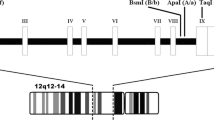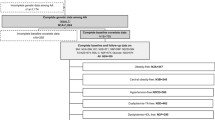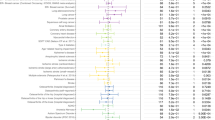Abstract
Longevity is a complex phenomenon involving multiple environmental and biological factors. Genetic studies of longevity have focussed on DNA repair, oxidative damage correction and immune-related genes. Vitamin-D works by modulating mineral homeostasis and key physiological processes such as cell proliferation and immune response. Vitamin-D insufficiency has been largely considered a risk factor for life-limiting illnesses including cardiovascular and immune-related diseases and cancer. Vitamin-D acts through vitamin-D-receptor (VDR), which regulates the expression of vitamin-D-response genes. VDR variants have been associated with susceptibility to cancer, bacterial and viral infections, autoimmune diseases, and allergies. In the present study we evaluated VDR as candidate gene involved in human longevity. We selected five polymorphisms of the VDR gene that capture variability at the 5′, coding and 3′ regions. Genotype data was obtained from 104 octogenarians (>85 years) and 114 controls (17–40 years). Although differences in genotype and allele distribution did not reach statistical significance, haplotype distribution was distinctive, mainly for 3′ region haplotypes and particularly in males. Our results suggest a role for VDR gene variability in aging and longevity.



Similar content being viewed by others
References
Arai H, Miyamoto KI, Yoshida M et al (2001) The polymorphism in the caudal-related homeodomain protein Cdx-2 binding element in the human vitamin D receptor gene. J Bone Miner Res 16:1256–1264
Austad SN (2006) Why women live longer than men: sex differences in longevity. Gend Med 3:79–92
Barrett JC, Fry B, Maller J, Daly MJ (2005) Haploview: analysis and visualization of LD and haplotype maps. Bioinformatics 21:263–265
Bellamy RJ, Hill AV (1998) Host genetic susceptibility to human tuberculosis. Novartis Found Symp 217:3–13
Bonafe M, Olivieri F, Cavallone L et al (2001) A gender-dependent genetic predisposition to produce high levels of IL-6 is detrimental for longevity. Eur J Immunol 31:2357–2361
Capri M, Salvioli S, Monti D et al (2008) Human longevity within an evolutionary perspective: the peculiar paradigm of a post-reproductive genetics. Exp Gerontol 43:53–60
Chen TC, Chimeh F, Zhiren L et al (2007) Factors that influence the cutaneous synthesis and dietary sources of vitamin D. Arch Biochem Biophys 460:213–217
Danescu LG, Levy S, Levy J (2009) Vitamin D and diabetes mellitus. Endocrine 35:11–17
de la Torre MS, Torres C, Nieto G et al (2008) Vitamin D receptor gene haplotypes and susceptibility to HIV-1 infection in injection drug users. J Infect Dis 197:405–410
Deluca HF, Cantorna MT (2001) Vitamin D: its role and uses in immunology. FASEB J 15:2579–2585
Di Bona D, Vasto S, Capurso C et al (2009) Effect of interleukin-6 polymorphisms on human longevity: a systematic review and meta-analysis. Ageing Res Rev 8:36–42
Dobnig H, Pilz S, Scharnagl H et al (2008) Independent association of low serum 25-hydroxyvitamin d and 1, 25-dihydroxyvitamin d levels with all-cause and cardiovascular mortality. Arch Intern Med 168:1340–1349
Fang Y, van Meurs JB, d’Alesio A et al (2005) Promoter and 3′-untranslated-region haplotypes in the vitamin d receptor gene predispose to osteoporotic fracture: the Rotterdam study. Am J Hum Genet 77:807–823
Fibla J, Caruz A (2010) Vitamin D and HIV Infection. In: Alfano M (ed) Soluble factors mediating innate immune responses to HIV infection. Bentham eBooks, pp 180–229
Franceschi C, Motta L, Valensin S et al (2000) Do men and women follow different trajectories to reach extreme longevity? Italian Multicenter Study on Centenarians (IMUSCE). Aging (Milan) 12:77–84
Garland CF, Gorham ED, Mohr SB, Garland FC (2009) Vitamin D for cancer prevention: global perspective. Ann Epidemiol 19:468–483
Giacconi R, Cipriano C, Albanese F et al (2004) The -174G/C polymorphism of IL-6 is useful to screen old subjects at risk for atherosclerosis or to reach successful ageing. Exp Gerontol 39:621–628
González ER, Benavides FG, Mestre J (1996) La Transición Sanitaria en España desde 1900 a 1990. Rev Esp Salud Pública 70:221–233
Gouni-Berthold I, Krone W, Berthold HK (2009) Vitamin D and cardiovascular disease. Curr Vasc Pharmacol 7:414–422
Gross C, Eccleshall TR, Malloy PJ et al (1996) The presence of a polymorphism at the translation initiation site of the vitamin D receptor gene is associated with low bone mineral density in postmenopausal Mexican-American women. J Bone Miner Res 11:1850–1855
Halsall JA, Osborne JE, Potter L, Pringle JH, Hutchinson PE (2004) A novel polymorphism in the 1A promoter region of the vitamin D receptor is associated with altered susceptibility and prognosis in malignant melanoma. Br J Cancer 91:765–770
Hayes DP (2010) Vitamin D and ageing. Biogerontology 11:1–16
Heaney RP (2008) Vitamin D in health and disease. Clin J Am Soc Nephrol 3:1535–1541
Holick MF (2005) Vitamin D: important for prevention of osteoporosis, cardiovascular heart disease, type 1 diabetes, autoimmune diseases, and some cancers. South Med J 98:1024–1027
Holick MF (2006) High prevalence of vitamin D inadequacy and implications for health. Mayo Clin Proc 81:353–373
Holick MF, Chen TC (2008) Vitamin D deficiency: a worldwide problem with health consequences. Am J Clin Nutr 87:1080S–1086S
Ingles SA, Ross RK, Yu MC et al (1997) Association of prostate cancer risk with genetic polymorphisms in vitamin D receptor and androgen receptor. J Natl Cancer Inst 89:166–170
Jurutka PW, Remus LS, Whitfield GK et al (2000) The polymorphic N terminus in human vitamin D receptor isoforms influences transcriptional activity by modulating interaction with transcription factor IIB. Mol Endocrinol 14:401–420
Keisala T, Minasyan A, Lou Y-R et al (2009) Premature aging in vitamin D receptor mutant mice. J Steroid Biochem Mol Biol 115:91–97
Lamberg-Allardt C (2006) Vitamin D in foods and as supplements. Prog Biophys Mol Biol 92:33–38
Lanske B, Razzaque MS (2007) Vitamin D and aging: old concepts and new insights. J Nutr Biochem 18:771–777
Lash RW, Nicholson JM, Velez L, Van Harrison R, McCort J (2009) Diagnosis and management of osteoporosis. Prim Care 36:181–198
Lewontin R (1988) On measures of gametic disequilibrium. Genetics 120:849–852
Li N, Stephens M (2003) Modeling linkage disequilibrium and identifying recombination hotspots using single-nucleotide polymorphism data. Genetics 165:2213–2233
Lio D, Scola L, Crivello A et al (2002a) Allele frequencies of +874T→A single nucleotide polymorphism at the first intron of interferon-gamma gene in a group of Italian centenarians. Exp Gerontol 37:315–319
Lio D, Scola L, Crivello A et al (2002b) Gender-specific association between -1082 IL-10 promoter polymorphism and longevity. Genes Immun 3:30–33
Lips P (2006) Vitamin D physiology. Prog Biophys Mol Biol 92:4–8
Morrison NA, Qi JC, Tokita A et al (1994) Prediction of bone density from vitamin D receptor alleles. Nature 367:284–287
Nyholt DR (2004) A simple correction for multiple testing for single-nucleotide polymorphisms in linkage disequilibrium with each other. Am J Hum Genet 74:765–769
Pike JW (1991) Vitamin D3 receptors: structure and function in transcription. Annu Rev Nutr 11:189–216
Pilz S, Dobnig H, Nijpels G et al (2009) Vitamin D and mortality in older men and women. Clin Endocrinol (Oxf) 71:666–672
Razzaque MS, Lanske B (2006) Hypervitaminosis D and premature aging: lessons learned from Fgf23 and Klotho mutant mice. Trends Mol Med 12:298–305
Roth SM, Zmuda JM, Cauley JA, Shea PR, Ferrell RE (2004) Vitamin D receptor genotype is associated with fat-free mass and sarcopenia in elderly men. J Gerontol A 59:10–15
Shroff R, Egerton M, Bridel M et al (2008) A bimodal association of vitamin D levels and vascular disease in children on dialysis. J Am Soc Nephrol 19:1239–1246
Stephens M, Smith NJ, Donnelly P (2001) A new statistical method for haplotype reconstruction from population data. Am J Hum Genet 68:978–989
Sullivan KM, Dean A, Soe MM (2009) OpenEpi: a web-based epidemiologic and statistical calculator for public health. Public Health Rep 124:471–474
Tuohimaa P (2009) Vitamin D and aging. J Steroid Biochem Mol Biol 114:78–84
Tuohimaa P, Tenkanen L, Ahonen M et al (2004) Both high and low levels of blood vitamin D are associated with a higher prostate cancer risk: a longitudinal, nested case-control study in the Nordic countries. Int J Cancer 108:104–108
Uitterlinden AG, Fang Y, van Meurs JB, Pols HA, van Leeuwen JP (2004a) Genetics and biology of vitamin D receptor polymorphisms. Gene 338:143–156
Uitterlinden AG, Fang Y, van Meurs JB, van Leeuwen H, Pols HA (2004b) Vitamin D receptor gene polymorphisms in relation to Vitamin D related disease states. J Steroid Biochem Mol Biol 89–90:187–193
Visser M, Deeg DJ, Lips P (2003) Low vitamin D and high parathyroid hormone levels as determinants of loss of muscle strength and muscle mass (sarcopenia): the Longitudinal Aging Study Amsterdam. J Clin Endocrinol Metab 88:5766–5772
Wall JD, Pritchard JK (2003) Haplotype blocks and linkage disequilibrium in the human genome. Nat Rev Genet 4:587–597
Wang TT, Nestel FP, Bourdeau V et al (2004) Cutting edge: 1,25-dihydroxyvitamin D3 is a direct inducer of antimicrobial peptide gene expression. J Immunol 173:2909–2912
Wingard DL (1984) The sex differential in morbidity, mortality, and lifestyle. Annu Rev Public Health 5:433–458
Acknowledgements
ML was recipient of a fellowship from the University of Lleida. This work was supported by grants to the University of Lleida (JF, principal investigator) from Fondo de Investigación Sanitaria (FIS, PI051778) and Ministerio de Ciéncia e Innovación (CGL 2007-62875). We thank Elaine Lilly, Ph.D. (Writer’s First Aid), for English language revision of the manuscript. We would like to thank the elderly participants and their families, who made this study possible.
Author information
Authors and Affiliations
Corresponding author
Rights and permissions
About this article
Cite this article
Laplana, M., Sánchez-de-la-Torre, M., Aguiló, A. et al. Tagging long-lived individuals through vitamin-D receptor (VDR) haplotypes. Biogerontology 11, 437–446 (2010). https://doi.org/10.1007/s10522-010-9273-8
Received:
Accepted:
Published:
Issue Date:
DOI: https://doi.org/10.1007/s10522-010-9273-8




